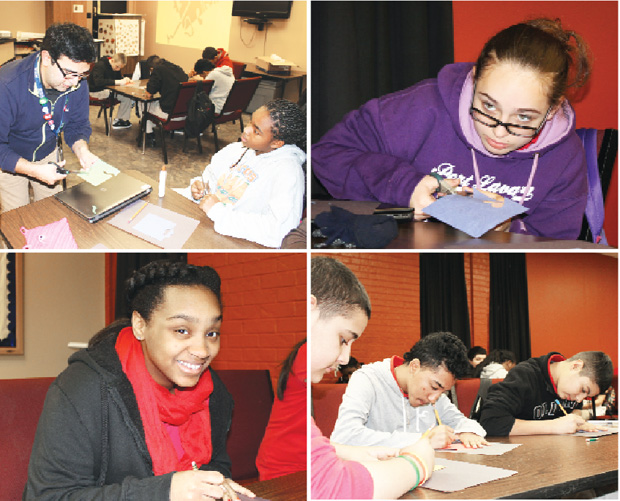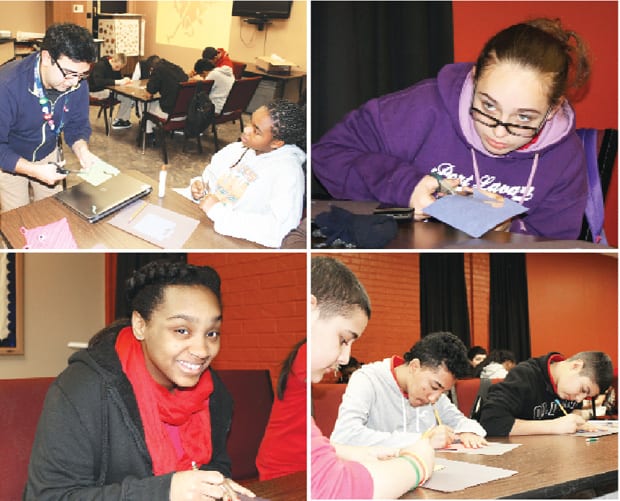Out art teacher Jerome Larez develops his students’ artistic skills, knowing it will help them excel in the core subjects like math and science

BUILDING THE ARTS | Students in Jerome Larez’s 8th grade art class at Legacy Preparatory Charter Academy work on various projects that will help them develop skills in the core subjects. Larez is looking for funding that will cover the costs of taking his students to the city’s museums. (Steve Ramos/Dallas Voice)
The University of California, Berkeley reported that when poet and former National Endowment for the Arts Chairman Dana Gioia gave the 2007 commencement address, he used the occasion to deliver an impassioned argument for the value of the arts and arts education.
“Art is an irreplaceable way of understanding and expressing the world,” Gioia said. “There are some truths about life that can be expressed only as stories, or songs or images. Art delights, instructs, consoles. It educates our emotions.”
Over a thousand miles away in Dallas, an art teacher at Legacy Preparatory Charter Academy has a curriculum designed to give his students those “truths about life.”
Jerome Larez guides about 325 students, from kindergarten to 8th grade, through various art forms he believes will give them a better understanding of their world.
“Within my own art, I try to bring out the beauty I see in the world,” Larez said. “But in my classroom, I not only try to instill that idea into my students, I also teach them a visual language.”
Larez said the average American looks at 2,000 images a day, including billboards, computers and video games.
“Kids are bombarded with those images, so how do we sift through them?” he asked. “It’s important to learn a visual language, and art gives us the ability to communicate.”
Larez graduated from Texas Tech University with a degree in studio art photography. His master’s is in photo theory. In his first year of teaching at Legacy, he’s introducing his students to various art mediums, including painting, graphite, sculpture, mixed media and digital.
“The students are aware there are different art-making processes,” Larez said. “Through our studies, they not only can identify an art piece, but they can describe it, analyze it and make interpretations from it.”
But how do those skills help students academically, and are smart people drawn to the arts or does arts training make people smarter? Again, Berkley weighs in.
Under the leadership of neuroscientist Michael S. Gazzaniga, the Dana Arts and Cognition Consortium assembled neuroscientists from seven universities to study whether dance, music, theater and visual arts might affect other areas of learning — and how.
Berkeley reported that after more than three years of research, the results of a $2.1 million project were published in a report titled “Learning, Arts and the Brain.”
Several studies in the report suggested that training in the arts might be related to improvements in math or reading skills. In one of the studies, a University of Oregon team, headed by psychologist Michael Posner, observed the brain activity of children 4 to 7 years old while they worked on computerized exercises intended to mimic the attention-focusing qualities of engaging in art. The researchers concluded that the arts can train children’s attention, which in turn improves cognition.
For 8th-grade student Kayren Cox, the cerebral complexities behind her art projects are better left to the highbrows.
“I just like what we’re doing,” she said. “I love art class. I’ve learned a lot about art in Mr. Larez’s class. I don’t know if I’m good enough to go on with it, but it’s something I think will always help me.”
Larez does know the importance of the relationship between art and the core subjects, but he’s also working to take the education out of the classroom and into the city’s museums. Financial realities, however, are making that project difficult.
“It would cost about $2,000 to take the students to a museum, but it’s so important to get them there,” he said. “They need to see the art movements we’ve been talking about in the classroom, and they’re excited about going to the museum, but we’ve got to come up with the money.”
Legacy’s administration is supportive of Larez’s curriculum and his openness about being gay at the school.
“I think they knew when I applied and handed them my resume,” he said. “I have a project called Hope Is Never Silent, which is an art organization that displays queer art.”
Larez had a recent showing of the art at the ilume Gallerie, and his goal is not only to highlight LGBT artists but allies, too.
“The art brings out the issues we go through in the community,” he said. “We see the struggles in the art pieces.”
Currently, Larez is occupied with the struggle of finding the funding to cover the costs of the bus to get his students to the museums.
“As a photographer, I frame the world as I would in a camera’s viewfinder,” he said. “I see detail. When I look at my students through that viewfinder, I see the details there, too. I see future artists, engineers and scientists. I hope my work in the classroom gets them there.”
This article appeared in the Dallas Voice print edition March 14, 2014.


